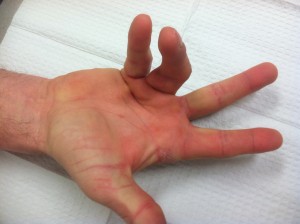This article was published in the Triangle Physician Magazine, February 2014 issue.
Dupuytren’s disease is a benign, fibroproliferative disorder affecting the hands of many adults. The condition is characterized by abnormal deposition of collagen within the palmar fascia of the hand leading to development of nodules and cords in the palm. As the pathologic fibrous tissue contracts, progressive flexion deformities of the digits develop which prevent the patient from fully straightening the digits. The condition is most commonly seen in men over the age of 40, and the incidence increases in older populations. Dupuytren’s disease is thought to be a disorder of autosomal dominant inheritance of variable penetrance. Due to the high prevalence of disease in patients of Scandinavian, Celtic, and Northern European ethnicity, it has been speculated that the Vikings distributed this genetic predilection during their travels.

The clinical course of Dupuytren’s disease is variable, but most patients develop slowly progressive painless flexion contractures in the small and ring fingers. As the joint contractures worsen, patients report functional difficulty with shaking hands, wearing gloves, and reaching into a pocket. Patients with more aggressive disease may also develop plantar fibromatosis (Lederhose’s disease) and penile involvement (Peyronie’s disease).
The treatment of patients with Dupuytren’s disease is individualized, and is dependent upon patient age, degree of flexion contracture, extent of disease, and patient desires. For patients with minimal flexion contractures, education about Dupuytren’s disease is provided and observation is recommended. Patients are instructed to report when they can no longer place their hand flat on a table (the “table top test”). Most surgeons recommend intervention when a patient develops a functionally limiting contracture in a digit.
There is no known cure for Dupuytren’s disease. However, current treatment is aimed at reducing flexion contractures, improving joint range of motion, and restoring hand function. Oral medications, splinting, and hand therapy have not been clinically proven to be effective in patients with Dupuytren’s contractures. Intralesional corticosteroid injections may soften Dupuytren’s nodules and cords, but this medication does not relieve joint contractures. Radiotherapy has gained interest in Europe but is not commonly performed for this condition in the United States.
The traditional treatment option and current gold-standard is surgical fasciectomy. In this procedure, the diseased fibrous tissue is meticulously dissected and excised, allowing the joint contractures to be released. Post-operative splinting and hand therapy are recommended for several weeks afterwards. Most patients achieve significant improvement in function and digit range of motion after surgical treatment.
Less-invasive percutaneous treatments for Dupuytren’s have recently been promoted. These options include collagenase injections (Xiaflex) and needle aponeurotomy (NA), both of which can be performed in the office. Percutaneous techniques are gaining favor among surgeons and patients, due to quicker recovery and low complication rates. Some patients who are not good surgical candidates due to medical co-morbidities may be better candidates for less-invasive techniques. Collagenase injections were FDA approved in 2010 after demonstrating promising results and high patient satisfaction in the hand surgery literature. This medication dissolves Dupuytren’s tissue, allowing the surgeon to disrupt the pathologic cords as an office-based procedure. The recent clinical results with collagenase use in our office have been encouraging.
